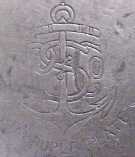I have a set of Tiffany candlesticks that are sterling with a loaded base. What does this mean and is the value affected? What would a set of sterling candlesticks be worth? Thank you.
I should have noted that the base says cement filled. Thank you.
It means that the base is filled with a heavy material, like cement, to make them more stable - so they won’t fall over. Has no effect on the value of sterling items such as candlesticks or vases. Watch ebay and search the completed items there to get a real world idea of value.
Regards,
Uncle Vic
The Realities of Weighted Sterling
(Copyright Jeffrey Herman)
The article below discusses weighted sterling that is reinforced throughout the entire object. These are pieces that would not be functional if the silver alone was their only support.
You just forced a candle into one of the candle cups of a weighted, two-arm candelabra. What you didn’t expect to experience was the arm being ripped from its stem. Have you ever polished a candlestick and wondered what that rattling noise was? I know all too well what that sound is: it’s cement (most commonly pitch, which is made from various percentages of pine resin and plaster) had reduced in volume when it was first poured, then cooled inside the object, creating a void. This will allow pieces of this brittle material to break off and rattle inside that space. Weighted sterling may also contain, lead, wax, sand, or some other material for support. Since the sterling is very thin (I’ve measured metal thickness as thin as .003"), there is then not enough support for that area of your object to withstand a dent when lightly tapped against a hard surface. You’ll also find pitch inside most dresser brushes and hand mirrors that probably show signs of denting from even the most cautious user. You may have seen a dresser brush with very deep embossing, revealing a cherub with a hole in its nose. At that very point, the material may have been only .002" thick when it came out of the factory. Sliding the brush over a dressing table a few times and heavy-handed polishing may have been all it took to go through that nose. If these pieces were not weighted, they would almost collapse! If you are the victim of one of these pieces, I know your frustration.
What you may not be aware of is that although your candelabra may weigh a hefty four pounds (64 ounces), in reality it contains only about 6.4 ounces (5.83 troy ounces) of sterling! Simplified, this means your candelabra is composed of 10% sterling and 90% pitch. So, if you wanted to scrap that candelabra using a $10 silver market, the refiner would pay you no more than $48. Something else to keep in mind: many refiners will also charge a refining fee of $50 or more. You just lost two dollars! Stunned? You’re not alone.
Welcome to the sad reality of weighted sterling. When the silver companies first introduced objects that were made of this paper-thin sterling, they intended on making utilitarian holloware and dresserware that was more affordable to the mass-market. Though you may have thought you were purchasing a quality piece of silver, it later turned out to be nothing but aggravation in its use and cleaning.
Also, this thin material is not easily repaired. In fact, most restoration services will not work on weighted sterling. If you have a piece in need of repair, please e-mail detailed images of it for an estimate.
I’m sure there are some weighted/filled candlesticks that have just had some weight added to the base for stability, but, as Jeffrey, notes a lot of cement-filled items have cement all the way through the candlestick’s column, and the silver itself is as thin as the aluminum in a soda can. As you can imagine, you can practically dent such items just by looking at them wrong!
A candlestick was recently offered on eBay; the seller described a “crinkly” design on the base. What the accompanying photos showed, in fact, was that the “crinkling” was actually deformed metal, the silver had crumpled up when the base was torqued in relation to the column. Kind of an eye-opener, and gave me a whole new perspective on filled silverware.
PLEASE!! Does anyone know what company this “Hallmark” is? Please and thank you for any help.
